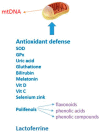Mitochondrial Oxidative Stress-A Causative Factor and Therapeutic Target in Many Diseases
- PMID: 34948180
- PMCID: PMC8707347
- DOI: 10.3390/ijms222413384
Mitochondrial Oxidative Stress-A Causative Factor and Therapeutic Target in Many Diseases
Abstract
The excessive formation of reactive oxygen species (ROS) and impairment of defensive antioxidant systems leads to a condition known as oxidative stress. The main source of free radicals responsible for oxidative stress is mitochondrial respiration. The deleterious effects of ROS on cellular biomolecules, including DNA, is a well-known phenomenon that can disrupt mitochondrial function and contribute to cellular damage and death, and the subsequent development of various disease processes. In this review, we summarize the most important findings that implicated mitochondrial oxidative stress in a wide variety of pathologies from Alzheimer disease (AD) to autoimmune type 1 diabetes. This review also discusses attempts to affect oxidative stress as a therapeutic avenue.
Keywords: antioxidant therapy; mitochondria; mitochondrial diseases; oxidative stress.
Conflict of interest statement
The authors declare no conflict of interest.
Figures


References
Publication types
MeSH terms
Substances
LinkOut - more resources
Full Text Sources
Medical

